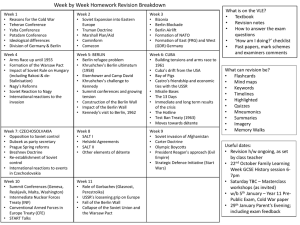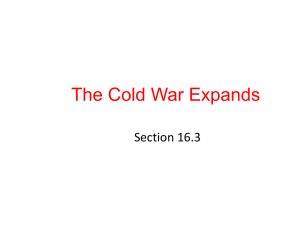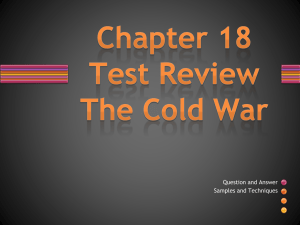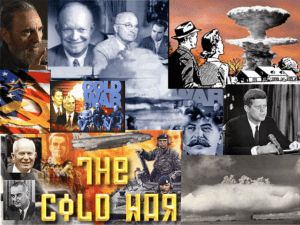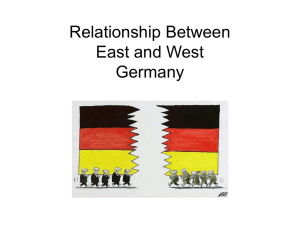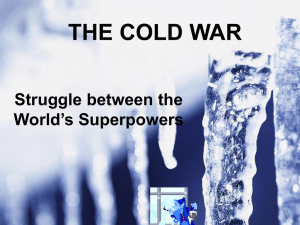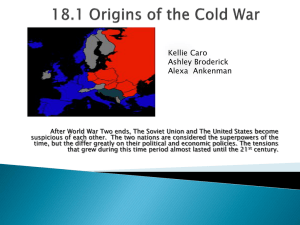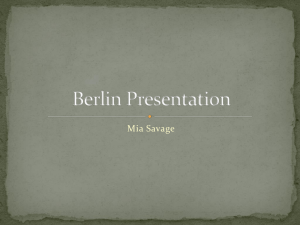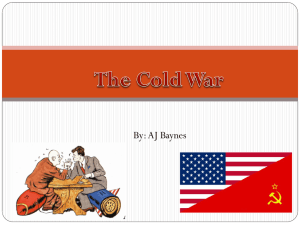The Cold War in Europe
advertisement
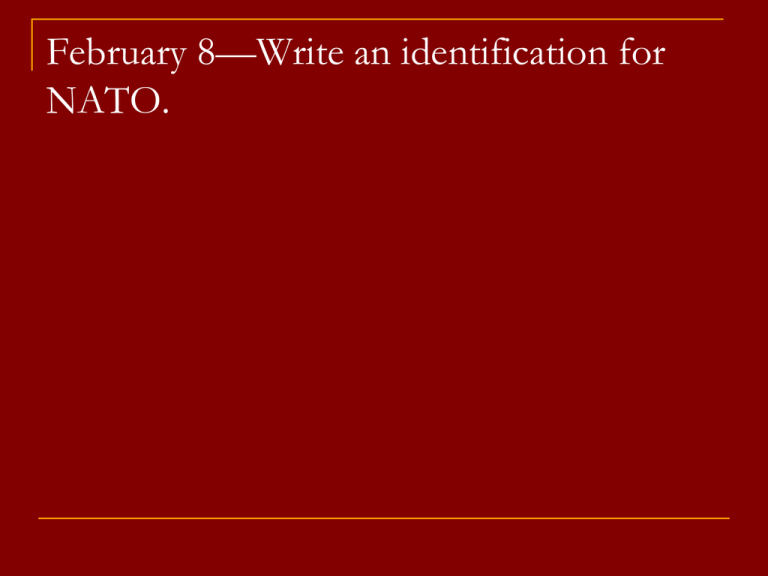
February 8—Write an identification for NATO. NATO vs. Warsaw Pact NATO •Wants to strengthen democracy •Agreement between North Atlantic countries •Made in 1949 •Still exists •Settle disputes peacefully using the UN •Members will defend each other •Establish a council of members •New members can join Warsaw Pact •Includes a requirement to reduce armaments and prohibits weapons of mass destruction •Between communist countries in Europe •Made in 1955 •No longer exists Read “Who’s to Blame for the Cold War?” on p. 906 in AP and take notes Orthodox Revisionist Radical Revisionist Post-revisionist The Cold War in Europe 1945-1968 Students will be able to explain and analyze Ideological differences and opposition Mutual suspicion and fear Superpowers and spheres of influence Alliances and diplomacy Containment, brinkmanship, peaceful coexistence, and détente UN Arms Race, proliferation and limitation Sample Paper 2 Questions Assess the part played by differing ideologies in the origin of the Cold War. Analyse the origin of the East-West rivalry and explain why it developed into the Cold War. For what reasons, and with what results, did the Truman Doctrine and the Marshall Plan affect Cold War development? Explain the meaning of 2 of the following and show how each affected the development of the Cold War: containment; brinkmanship; nonalignment; détente. Sample Questions For what reasons, and with what results, were the disagreements between participants at the conferences of Yalta and Potsdam in 1945? Define and analyse the importance of two of the following: (a) the formation of NATO; (b) the Warsaw Pact; (c) non-alignment; (d) détente. Key Terms Berlin Blockade Suez Crisis Hungarian Uprising U-2 Incident Berlin Wall Prague Spring Brezhnev Doctrine Lecture Outline I. US Loans II. Truman Doctrine III. Marshall Plan IV. Berlin Blockade V. The Suez Crisis and the Hungarian Revolt VI. U-2 Incident VII. Prague Spring and the Brezhnev Doctrine US Loans In January 1945 Stalin requested a $6 billion post-war recovery loan for the Soviet Union. The US State Department refused to discuss the matter unless Stalin became more receptive to US demands in Europe. Later in 1945 the Soviets asked for a $1 billion loan. The official US government explanation to this day is that the request was “lost.” US Loans When it was “found” months later, the State Department offered to discuss the loan if the Soviets would pledge “non-discrimination in international commerce” allowing US investment and goods into Eastern Europe. The US had loaned Great Britain $4 billion and France $1 billion. Truman Doctrine At the UN Security Council in January 1946, the Soviet Union condemned persecutions of leftists in Greece—1,219 of them had been assassinated and 18,767 arrested. A civil war in Greece began in March 1946. Over 600,000 Greeks were killed from 1940 to 1949. Resulted in the Truman Doctrine and $400 million in aid for Greece and Turkey. Marshall Plan $5 billion was appropriated in April 1948. By 1952 when military aid began to replace economic assistance, the US has expended nearly $14 billion to promote European recovery. Europe’s economic productivity increased by nearly 200% from 1948 to 1952. Berlin Blockade On June 23, 1948 the US introduced West German currency into West Berlin. The Soviets established a blockade on all road, rail, and barge traffic into the city. The West set up a counter-blockade on the movement of goods from the Eastern Europe into West Germany. The American and British supplied West Berlin with an airlift, flying 5,000 tons of goods a day. Berlin Blockade Berlin Blockade In July 1948 the US sent 2 groups of B-29s to Britain. In April 1949 the US and 11 other nations created NATO. On May 12, 1949 the Soviets ended their blockade of Berlin. Suez Crisis In late 1955 the President of Egypt, Gamal Abdel Nasser, negotiated a weapons deal with Communist Czechoslovakia that seemed to threaten US influence in the Middle East. The US offered Egypt technical and financial aid to build the Aswan Dam. In July 1956, after Nasser refused to repudiate the Czech arms deal and recognized Communist China. The US pulled their offer. Suez Crisis Nasser immediately nationalized the Suez Canal which gave him the $25 million annual profit from the canal operation. In September 1956 Britain, France and Israel signed a secret agreement in which the Israeli army agreed to a fake an assault on the Canal. In return, the Israelis would receive British and French air and naval support as its armed forces attacked and destroyed Egypt’s army in Sinai and opened the Straits of Tiran. Suez Crisis In October 1956 Israel invaded Egypt. It quickly destroyed the Egyptian army and captured most of the Sinai Peninsula. On October 30, 1956 the Europeans began to bomb Egyptian targets. The US introduced a resolution in the UN General Assembly urging a truce and imposed an oil embargo on Britain and France. The British and French agreed to a ceasefire and a quick withdrawal from Egypt. Suez Crisis Hungarian Revolt Oct. 23, 1956 Hungarian students began protests that demanded the removal of the Red Army from Hungary and the creation of an anti-Communist political party. October 28 Soviet troops leave Budapest. Voice of America and Radio Free Europe encouraged the rebels and the US promised economic aid to those countries that broke free from the Soviet sphere. Hungarian Revolt October 31 Imre Nagy announced that Hungary was withdrawing from the Warsaw Pact. Soviets used the Suez Crisis as a cover and moved the Red Army back into Budapest. 7,000 Soviets and 30,000 Hungarians died. 50,000 Hungarians fled the country. Nagy was executed. Eisenhower never contemplated helping Hungary. March 8—Write an identification for the Hungarian revolt. The U-2 Incident In 1956 the US started a series of flights over the Soviet Union in high-altitude photograph airplanes called U-2s. In September 1959 Khrushchev visited the US and he and Eisenhower agreed to hold a summit meeting in Paris in May 1960. On the eve of the summit, Khrushchev announced that the Soviets had shot down a U-2 plan over the Soviet Union. Khrushchev produced the pilot, Francis Gary Powers, and the conference was ruined. Berlin Wall On August 13, 1961 Khrushchev decided to build the Berlin Wall. The Prague Spring In October 1964 the Politburo removed Khrushchev from power and Leonid Brezhnev became the leader of the Soviet Union. In January 1968 Alexander Dubcek became the leader of Czechoslovakia. The Prague Spring The increased liberalization of the Czechoslovakian economy and society became known as “the Prague Spring.” In August 1968, 200,000 Warsaw Pact troops invaded Czechoslovakia. Brezhnev Doctrine In November 1968 Brezhnev defended the invasion of Czechoslovakia in a speech that later became known as the Brezhnev Doctrine, which stated that the USSR would define the “correct” form of socialism, and no Eastern European country would be allowed to deviate from the Soviet view, leave the Warsaw Pact, or overthrow the Communist Party’s monopoly on power.

